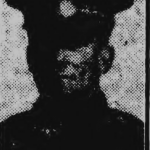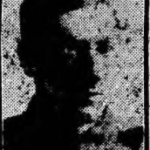BORN HULL 1881. SON OF WILLIAM HENRY WILKINSON (1853-1896) AND MARY ANN ELSEY (1854-1925), AT AT 9 SOUTH VIEW, ST GEORGE’S ROAD, HULL AND 115 WALTON STREET, HULL. HE HAD THREE BROTHERS AND THREE SISTERS. 115 WALTON STREET, HULL. HIS WIFE AGNES JANE & TWO CHILDREN LIVED AT 1 HODGE STREET, DRYPOOL AND 66 , WHEELER STREET, HULL (WAR PENSION ADDRESS). EMPLOYED AT MESSRS, AIRE AND CALDERS, AS A WARHOUSE FOREMAN.
HE ENLISTED IN THE HULL PALS. SERVED WITH THE 13TH EAST YORKSHIRE REGIMENT IN EGYPT AND FRANCE. TRANSFERRED TO THE 8TH EAST YORKSHIRE REGIMENT. DIED OF WOUNDS, ON 25/07/1916, AGED 35. BURIED ON THE SOMME. HIS DEATH WAS REPORTED IN THE HULL DAILY MAIL, ON 14/06/1917. *
HE ENLISTED IN THE SAME REGIMENT AS HIS BROTHER, SERGEANT, HARRY MANLEY WILKINSON, OF 94 PLANE STREET, HULL. HARRY TRANSFERRED TO THE 4TH EAST YORKSHIRE REGIMENT, WHO WAS KILLED ON 28/03/1918. THEIR OTHER BROTHER, RAYMOND, SERVED IN THE ROYAL GARRISON ARILLERY.
Somme – The 8th East Yorkshires spent the following weeks alternating between resting, training, and spells in the line near Dickebusch, while preparations went on further south for that summer’s ‘Big Push’ (the Battle of the Somme). The battalion entrained for the Somme on the day the offensive began, 1 July. It went into brigade reserve when 3rd Division took over the Caterpillar Wood sector near Montauban, providing carrying parties and night patrols. After the disasters of the first day, 3rd Division in conjunction with three others was to make a daring night assembly and dawn attack on 13/14 July (the Battle of Bazentin Ridge). The Brigade Intelligence Officer had placed a screen of picquets and scouts out in No man’s land within 200 yards (180 m) of the enemy line and the assaulting troops slowly moved up in the hours of darkness to a sunken lane just short of this line. They then moved forwards 15 yards every 15 minutes until they were on their jumping-off tapes about 120 yards (110 m) from the enemy by 03.15; 8th EYR was on the right of 8th Bde’s line, with half of 1st Royal Fusiliers in support. At 03.20 a sudden intense bombardment was placed on the German barbed wire and trenches and five minutes later the whole attacking line of four divisions advanced behind a Creeping barrage. Along most of the line the German resistance was feeble; unfortunately the wire in front of 8th Bde was hardly touched, there were just a few breaks in the first belt and none in the second. Two platoons of the 8th EYR managed to get through on the right, the remainder had to shelter in shell holes in front of the wire or retire to the sunken road. Lieutenant-Colonel Way was wounded in the wire and Maj Brewis came up to take temporary command once more. Later a bombing party from 2nd Royal Scots came down from the left and cleared the Germans out of the trench in front of the battalion, but of the two platoons that had penetrated, no more was heard. In what was largely a successful British attack, the battalion had suffered severely, with 8 officers killed and 11 wounded, 81 other ranks killed, 218 wounded, and 141 missing, over half the initial strength of the battalion. Even when the battalion took over the opposing trenches they were heavily shelled with high explosive (HE) and gas until they were relieved on 20/21 July 1916. The success of 14 July left the British with an awkward salient south of Delville Wood, which was the scene of six more weeks’ bitter fighting (the Battle of Delville Wood). On 23 July 8th Bde held this salient round Waterlot Farm while the rest of the division attacked Delville Wood. The brigade’s contribution to the attack was to send out two strong bombing parties from 7th King’s Shropshire Light Infantry (KSLI), supported by a company of 8th EYR, trying to clear along the railway towards Guillemont station and widen the salient. They made little progress and fell back to Waterlot Farm, their attack having been disrupted by another division falling back from an attack on Guillemont. 8th East Yorkshires’ companies were now down to a strength of 40–50 each, but a draft of 320 reinforcements (from the Green Howards and the York and Lancaster Regiment) arrived that day. When relieved on 25 July the battalion consisted of 20 officers and 570 other ranks.

